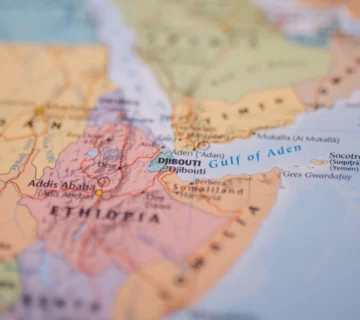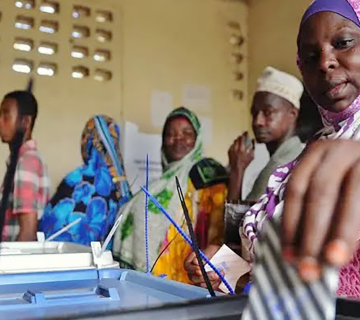Living in extreme conditions can be a daunting task. Only a few months ago, hundreds of children in many arid and semi-arid areas in the Horn of Africa countries of Somalia and Kenya were missing school because they were too hungry to attend it, or to stay there long enough for meaningful education to take place. Drought and famine had visited their villages for months, and many households were on the brink of starvation. Pests invaded farms. Crops failed. Malnutrition reached alarming levels. Wildlife-human conflicts escalated. Images of dying or dead animals and humans were shared via mainstream media and social media. In the tail end of 2017, Somalia was experiencing, “one of the worst droughts on record,” according to the United Nations Office for the Coordination of Humanitarian Affairs (UN-OCHA). UN-OCHA estimated that at least 2.8 million people, which is half the number of those adversely affected by famine in Somalia that year, needed humanitarian aid. Humanitarians appealed for funds to provide food, water, shelter, medicine to the most vulnerable populations. The 2018 Humanitarian Response Plan was initiated in Somalia, and an appeal of USD 1.5 billion made, according to UN-OCHA. Friends of Somalia had pledged USD 350 million to the Plan at the start of 2018.
Then the rain began to fall, filling the cracks in the previously thirsty ground, and exposing a myriad of vulnerabilities. In Kenya, some critical infrastructure, including link roads and bridges, could not withstand the strong water currents that the runoff water was creating; a few of these collapsed. Interestingly, other such infrastructure such as Ndakaini Dam, a water reservoir that supplies water to Kenya’s capital, Nairobi, has reportedly not been filling up as expected. It has also become clear that gutters in many urban areas are either blocked, inexistent, or unable to channel the excess water into rivers and/or water reservoirs. The result of too much water has been population displacement and loss of means of livelihood. The presence of flood water, not hunger, is now the top explanation for the absence of children in some schools in the country. The humanitarians are appealing for funds again, this time for food, safe water, shelter, and medicine for populations that have been displaced by flooding. On May 2, 2018, Kenya Red Cross Secretary General, Abbas Gullet, appealed for KSh. 499 million to address the problems caused by flooding in Kenya.
The Problem of Excessive Water
At least 32 of Kenya’s 47 counties have experienced above-average rainfall this year. The ones whose populations have been most affected by flooding are Tana River, Kilifi, Isiolo, Mandera, Marsabit, Turkana, Kisumu, Kitui, and Makueni. UN-OCHA has estimated that at least 260,000 people have been forced out of their homes by flood water in Kenya. Kenya Red Cross has reported a similar figure in an estimated “148,000 households,” according to Abbas.
Flooding has also been reported in different parts of Somalia, with Hirshabelle State being one of the worst affected, according to humanitarian agencies. In April 2018, Protection and Return Monitoring Network, a UN refugee agency-led initiative, estimated that both flash and river flooding had displaced 180,000 individuals, and affected “an estimated 630,000 people” across the country.
In addition to displacing populations, and destroying roads, bridges, and water sources, the flood waters have been blamed for the destruction of about 21,000 acres of farmland, the submerging of at least 100 schools and 40 health facilities, and the loss of about 20,000 livestock in Kenya. The exact cost of the flooding will become clearer in the coming days; it is likely to be in the millions.
The Case of Patel Dam
On the night of May 9, 2018, the walls of Patel Dam, private water reservoir near River Kabazi in Solai, Nakuru County, Kenya, collapsed releasing an estimated 20 million liters of water. The sudden release of about 20 tonnes of water destroyed buildings and farmland. A day after the incident, Kenya Police reported the death of at least 48 individuals. An unknown number of people are still missing, and search and rescue efforts – primarily by the Kenya Red Cross, Kenya Defense Forces, and National Youth Service – are ongoing.
Fingers of blame have been pointed at the County Government of Nakuru, and the National Environment Management Authority who are responsible for issuing licenses and regulating different activities in communities. The Dam owner, Manskul Patel, a farmer who built the dam for irrigation, has not been spared, and questions have been raised on his decision to construct several earth dams in a populated area. Patel reportedly owns six other dams in the area. Investigations into culpability have begun, according to the governor.
Dam engineers have attributed the collapse of the mud dam to saturation; the earth could not absorb any more water. Solai and surrounding areas have been receiving rainfall for about at least a month. Residents of Nyakinyua and Energy villages have borne the brunt of the calamity.
The other dams in the area should be assessed and related issues (such as overflows and leakages) addressed to avoid a repeat of the Patel Dam tragedy.
Researchers have suggested the possible link between environmental destruction – including those caused by flooding – and the loss of livelihoods to increased engagement in radicalization and violent extremism. For example, in a study assessing terrorist threats in the Lake Chad Basin, Emeka Okereke, Ph.D., noted that the shrinking of Lake Chad has increased resource-related conflicts, and bolstered insecurity and terrorism in the Lake Chad Basin area, including the activities of Boko Haram. He also suggested that the terrorist threats by Boko Haram, and other such groups in the region, can be reduced by the rehabilitation and reinvention of Lake Chad.
Charcoal trade in Somalia has been cited as one of the sources of funding for al Shabab, an insurgent terrorist organization based in the country. A 2017 UN Somalia and Eritrea Monitoring Group report indicated that the charcoal trade generates an estimated USD 10 million (about KSh 1.03 billion) a year, which al Shabab has exploited to further its activities in Somalia and Kenya. This trade not only suggests the destruction of forest cover in the famine-prone country that promotes flooding, but also the fueling of conflict and terrorism in the country.
Finding a Balance
Residents in flood-prone areas have been asked to move to higher ground to prevent further loss of life. Abbas has called for the declaration of “a national disaster” to speed up responses to the emerging humanitarian situations.
Long term, governments, including those in the Horn of Africa, should encourage the planting of trees and other vegetation throughout the country, to gradually restore the forest cover, and reduce the impact of natural and man-made disasters in future. The forest cover of Kenya, one of the Horn of Africa countries that have experienced the most flooding this year, is under 10 per cent. The 2015 National Forest Policy estimates the forest cover in Kenya to be at about seven per cent (6.99). That Kenya’s President, Uhuru Kenyatta will lead a national tree-planting campaign dubbed ‘Panda Miti, Penda Kenya’ (which loosely translates to ‘plant trees, love Kenya’) on May 12, 2018, according to Manoah Esipisu, the State House Spokesman, is therefore a step in the right direction.
Communities living in the flood plain should move or be assisted to move to alternative sites, to preserve life and the environment. Further, technologies that support life in the event of flooding, such as those that channel runoff water safely into reservoirs, and floating rescue centres, for example, should be exploited for use by communities that are prone to both famines and flooding in the Horn of Africa region. It is a matter of time before the floods subside, and drought conditions return. Thus, effort should also be made to harvest as much of the runoff water as is possible to make the next dry spell more bearable for communities, especially those living in the arid and semi-arid areas of the Horn of Africa. Governments in the region should also assess the impact of adverse conditions on national and regional security, and ensure the needs of vulnerable communities that bear the impact of famine, drought, and flooding continuously are not exploited by extremist groups.
Roselyne Omondi is the Associate Director, Research, at the HORN Institute



